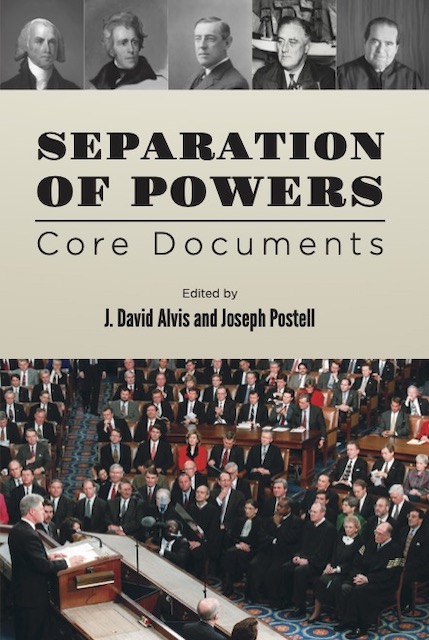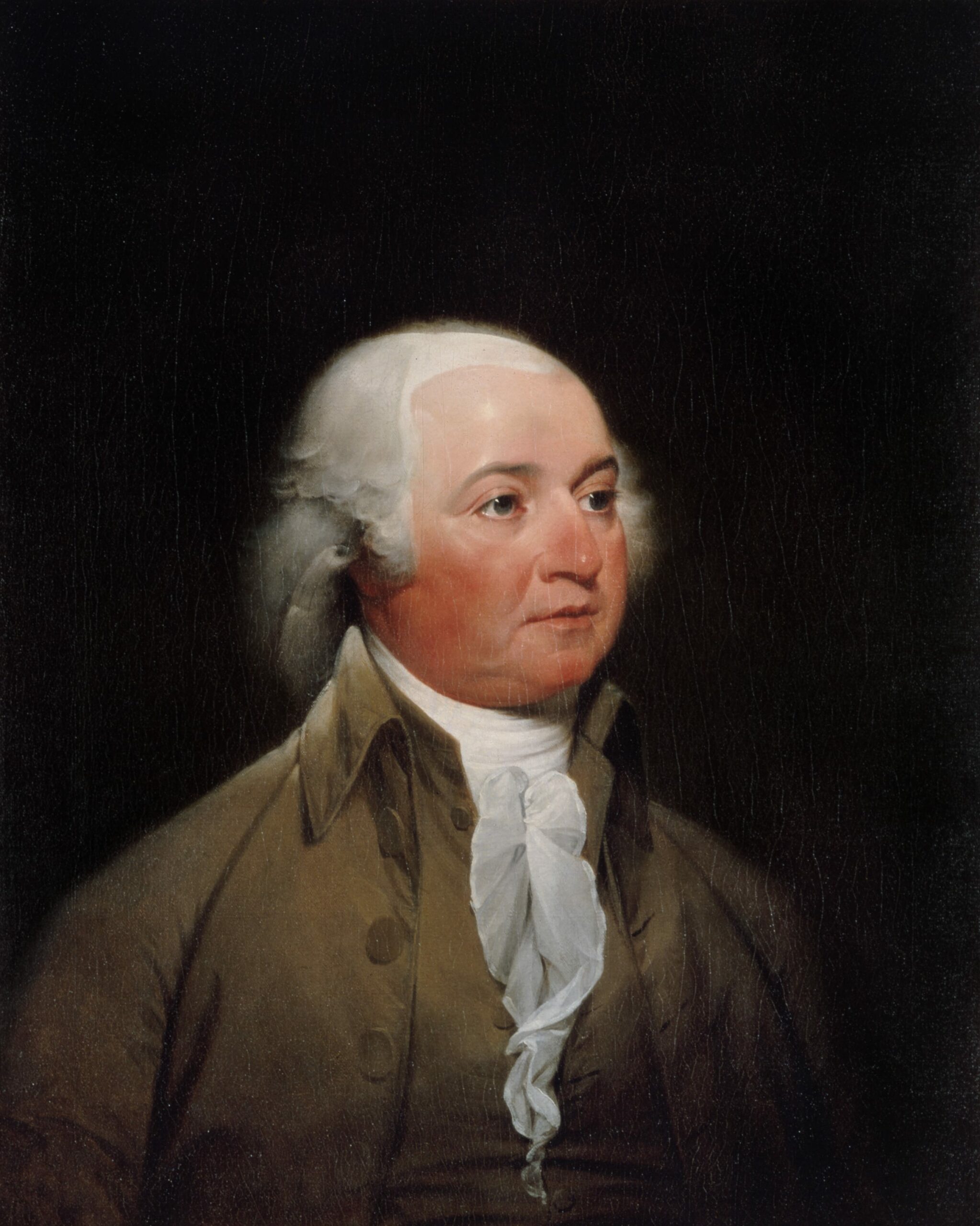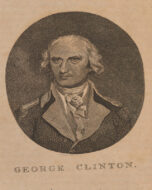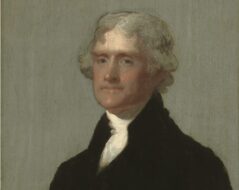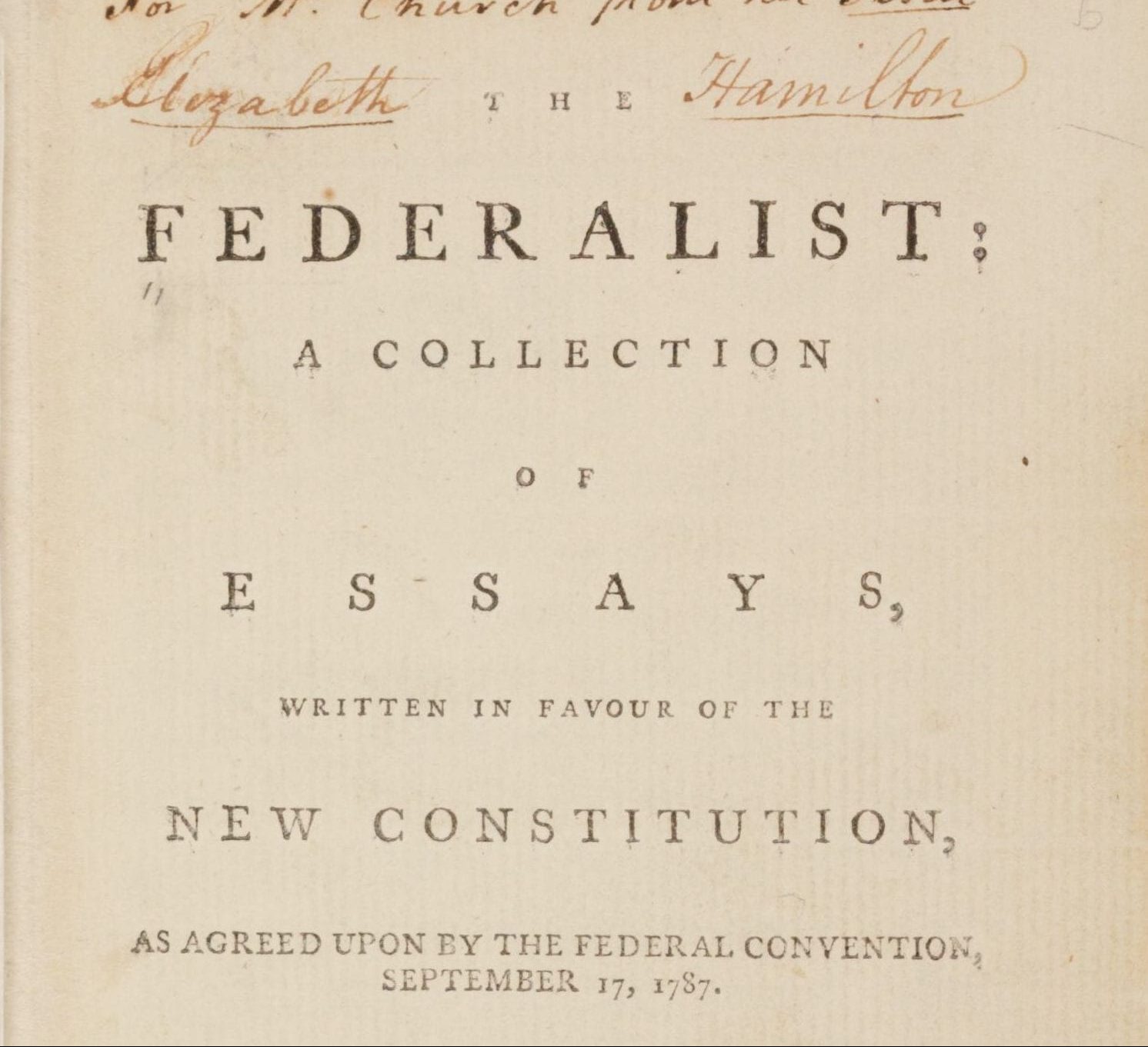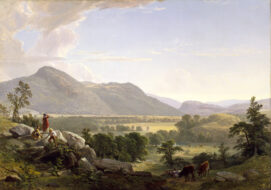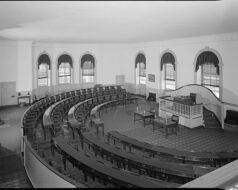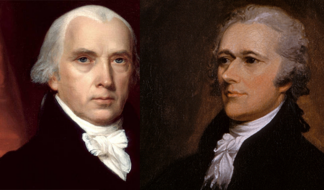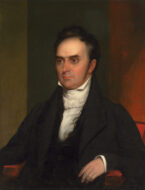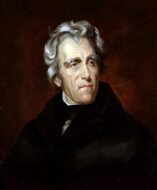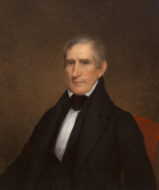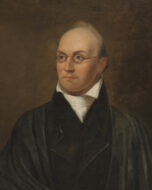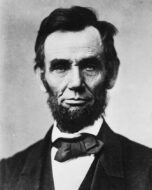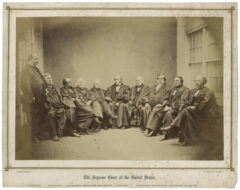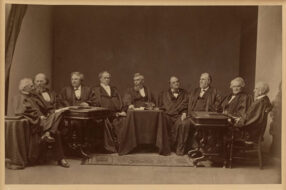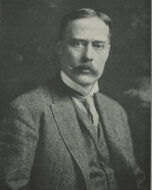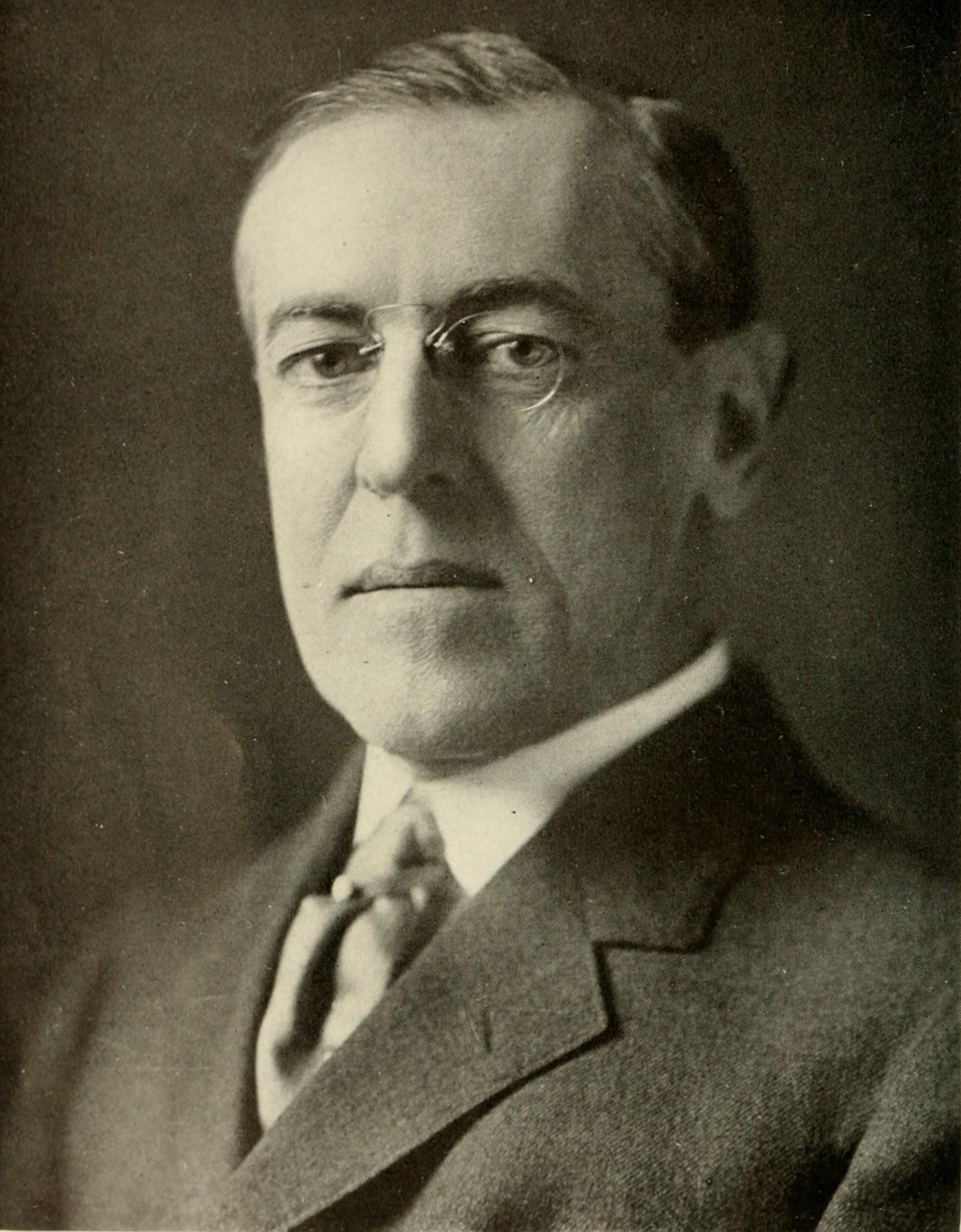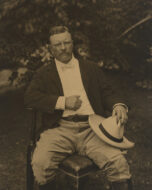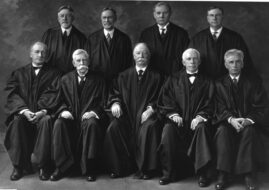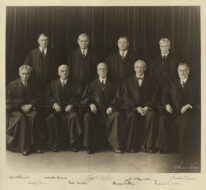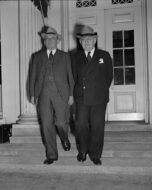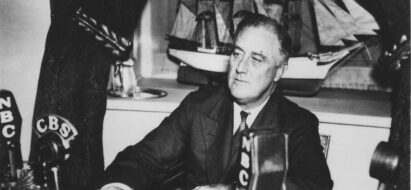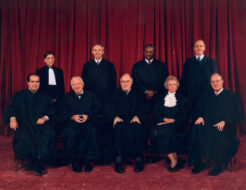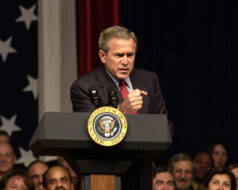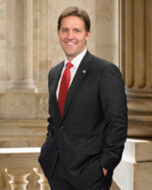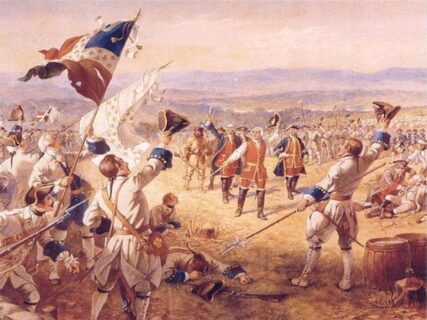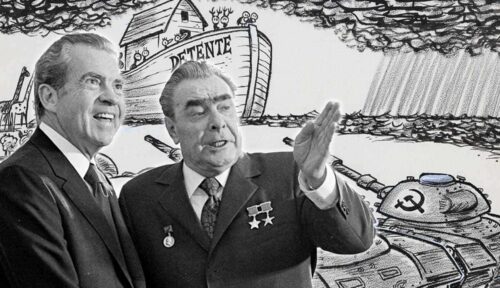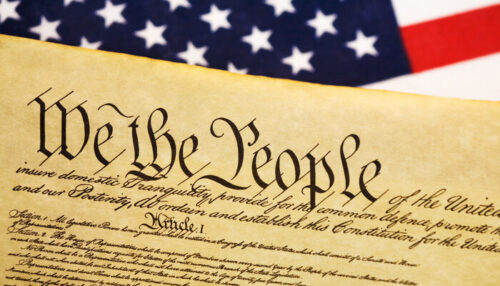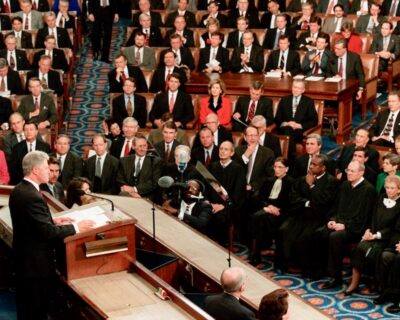
Separation of Powers
The separation of powers in the U.S. Constitution takes minutes to learn and a lifetime to master. It is simple to explain how the Constitution separates the powers of government. By virtue of the vesting clauses (provisions in the Constitution that grant authority to the main branches of government) in the first three articles, the Constitution locates the legislative, executive, and judicial branches of government in three separate institutions. The design is straightforward: Congress makes the law, the Executive executes the law, and the Judiciary interprets and applies the law.
As simple as this appears in theory, in practice it is very difficult both to define and to enforce the separation of powers. As James Madison wrote in Federalist 37 when reflecting upon the work of the Constitutional Convention:
Experience has instructed us that no skill in the science of government has yet been able to discriminate and define, with sufficient certainty, its three great provinces, the legislative, executive, and judiciary. . . . Questions daily occur in the course of practice, which prove the obscurity which reins in these subjects, and which puzzle the greatest adepts in political science.
Even Madison believed that it was impossible to define with certainty which powers belong to which branches. The difficulties in defining the boundaries of the legislative, executive, and judicial branches of government is the subject of this collection.
The Constitution separates the powers of government, yet it also partially blends them by bestowing some legislative power in the executive (e.g., the veto), and some executive power in Congress (e.g., the Senate’s power to advise and consent to the appointment of primary executive officers), while giving Congress and the president some influence over the courts (the power to appoint judges).
Furthermore, the powers themselves are not always easy to define. The debates in many of the documents included here reflect the ambiguity of the boundaries between the three powers of government. For instance, is the executive branch engaging in legislation when it formulates policy for implementing a congressional statute (See A.L.A. Schechter Poultry Corporation v. United States)? Does Congress have the power to define the limits on the president’s authority to remove officers who are employed by departments or agencies that the legislature created (See Debate in Congress over the Removal Power, Speech on the Appointing and Removing Power, Myers v. United States, Humphrey’s Executor v. United States)? Does the judiciary usurp executive power when it attempts to enforce its own decisions by appointing a prosecutor (See Mistretta v. United States, William Jefferson Clinton, Petitioner v. Paula Corbin Jones)? Despite the simple blueprint provided by the Constitution, the subsequent debates over the implications of this constitutional structure illustrate Madison’s prophetic concerns that “no skill in the science of government has yet been able to discriminate and define . . . its three great provinces.”
Separation of Powers and the American Founding
For the Founding generation, the separation of the powers was the sine qua non of good government. Almost no one at the time would have disagreed with Publius’ assertion in Federalist 47 that “the accumulation of all powers, legislative, executive, and judiciary, in the same hands, whether of one, a few, or many, and whether hereditary, self-appointed, or elective, may justly be pronounced the very definition of tyranny.”
Yet from the very beginning there was disagreement over the Constitution’s scheme. The Antifederalists accused the framers of the Constitution of having blended the powers: “The several departments of power are distributed and blended in such a manner as at once to destroy all symmetry and beauty of form, and to expose some of the essential parts of the edifice to the danger of being crushed by the disproportionate weight of other parts.”
Publius defended the fact that power is “blended” in terms of what we think of as “checks and balances.” To merely write down the separation of powers on paper and do no more is to trust “parchment barriers” to keep power in place. However, parchment barriers by themselves would not be effective. In Federalist 51, Madison explained the need for such auxiliary precautions:
The great security against a gradual concentration of the several powers in the same department, consists in giving to those who administer each department the necessary constitutional means and personal motives to resist encroachments of the others. The provision for defense must in this, as in all other cases, be made commensurate to the danger of attack. Ambition must be made to counteract ambition. The interest of the man must be connected with the constitutional rights of the place.
Putting Separation of Powers into Practice
As Madison anticipated, the adoption of the Constitution did not settle the question of how to “define” the precise boundaries between the three branches of government. The members of the respective branches had to work out those lines of division in practice. This collection of documents covers four main areas of debate over the course of American history that raise fundamental questions regarding the separation of powers.
While the framers separated the powers of government into three separate branches, the Constitution’s system of checks and balances blends these powers in such a way that the division of authority is less clear in practice. Article I of the Constitution vests the legislative power in Congress. But the Constitution gives the president two important roles in the legislative process: the veto power and the duty to make legislative recommendations to Congress. As a result, the president’s role in the process of making law continued to be a contested issue, with serious implications for the separation of powers.
Second, it remained to be decided what role Congress would play in the execution of the law. While Article II vests the power to execute the law in the president, Congress has the authority to create and fund the executive offices, and the Senate takes a role in approving principal executive officers. In practice, this raised the question of which branch had the final authority over how laws were executed.
Third, the Constitution allocates the power in foreign affairs in both the legislative and the executive branches, leading to contests between the branches over the exercise of these powers. As in the previous topics, this distribution of power also raised the question of which branch possessed the final authority over foreign affairs.
Finally, the Supreme Court plays a critical role in maintaining the separation of powers by serving as an umpire in the contests between the legislature and the executive. However, the Court’s ability to function in this role extends only so far as others are willing to recognize its authority. While the Constitution establishes the Court’s power in Article III, the scope and contours of its authority had to be established by subsequent decisions.
Separation of Powers and Lawmaking
While the Constitution vests the legislative power in Congress, the executive’s influence on the process of legislation has ebbed and flowed over the course of American history. During its first few years, Congress dissolved its House Ways and Means Committee, preferring instead to rely on the reports of Secretary of the Treasury Alexander Hamilton to set the legislative agenda. Many members wondered whether the legislature had ceded its lawmaking authority to the executive branch in doing so (See House Debate on the Influence of Alexander Hamilton). The Jeffersonians likened the Federalists in the executive branch to the practices of the British monarchy. This concern over legislatures delegating their powers to the executive branch even motivated colonial governor George Clinton to veto a bill creating a council that could adopt laws when the legislature was out of session.
While the balance of power temporarily shifted back to Congress with Jefferson’s defeat of the Federalists in 1800, the policies of Andrew Jackson once again raised the struggle to define the boundaries between the legislature and the executive in lawmaking (See Veto Message Regarding the Bank of the United States, Speech on the Presidential Veto of the Bank Bill, Message of Protest to the Senate, Speech on the Appointing and Removing Power). The formation of the Whig Party (a party which in England defended Parliament from the monarchy) in response to Jackson’s aggressive interpretation of presidential authority reflected deep concerns over executive usurpation of legislative power (see First Inaugural Address (1841)).
The twentieth century witnessed the rise of an even more legislatively proactive presidency. Presidents did not only threaten to veto bills they did not like, but actively intervened on behalf of legislation that they did like. Taking advantage of their access to a national constituency, presidents in the twentieth century attempted to cultivate popular support for certain legislative initiatives and to bring pressure on Congress to pass them.
This type of popular leadership, with the president serving as the “steward of the people” (See Theodore Roosevelt: An Autobiography), satisfied Progressives critical of the separation of powers. As Woodrow Wilson explained it: “There can be no successful government without leadership or without the intimate, almost instinctive, coordination of the organs of life and action.” Political leadership, according to Wilson and other Progressives, had been fettered by the division of powers imposed by the Constitution. During the early years of American history, there was very little need for the government to intervene in society, but modern industrialized society required a more active government and stronger leadership.
This vision of popular executive leadership was most effectively put into practice when presidents began using their control of the budget to influence the legislative process and set the legislative agenda (see Report of the President’s Committee on Administrative Management). The Office of Management and Budget created during the Nixon administration in 1970 allowed the president to overshadow Congress in fiscal and economic matters. Though Congress fought back by resuming control of certain parts of the budgeting process via the Congressional Budget and Impoundment Control Act and the creation of the Congressional Budget Office, the act has been ineffective in checking this growth of executive power.
In addition to the president’s new direct role in the legislative process, the rise of an enormous administrative state (executive agencies with the power to create, adjudicate, and enforce their own regulatory rules) shifted many of the duties that used to belong to the legislature to the executive branch. Progressives believed that lawmaking under the separation of powers had proven inefficient in regulating modern industrial innovation; such regulation required experts armed with broad discretionary powers who understood the issues and could act quickly.
FDR’s National Industrial Recovery Act (NIRA) in 1933 reflected the culmination of this Progressive vision of administrative policymaking. Under the NIRA, the federal government employed trade commissions composed of experts representing all sectors of industry to create codes of fair competition, which were then codified by the regulatory agencies and put into effect by executive order (See A. L. A. Schechter Poultry Corporation v. United States). While the Supreme Court struck down the NIRA in 1935 as a violation of the nondelegation doctrine (which holds that the legislature cannot delegate its lawmaking authority to another institution), Congress continued to delegate much of its responsibility for policymaking to various agencies across the administrative landscape, and the Court ultimately accepted these delegations (see William Clinton, President of the United States, et al., Appellants v. City of New York). Expert administrators eventually displaced the need for careful and prolonged congressional deliberation over public policy. Congress began to pass laws that provided general guidance but left the details to be sorted out by executive branch agencies through their rule-making. While Congress has attempted to create new institutional mechanisms to control the administration, including the legislative veto (a procedure whereby Congress passes a resolution suspending or nullifying an executive action), its efforts have often come into conflict with the Constitution (See Morrison v. Olson).
Concerns about the rise of an administrative state not controlled by Congress continue today. One U.S. senator recently lamented in his inaugural speech to the chamber that the administrative state has resulted in “legislative atrophy” and “executive overreach” (See Executive Overreach and the Separation of Powers). While the framers of the Constitution expected Congress to be the most important branch of government, Americans today look to the president to make policy and solve problems.
Separation of Powers and the Execution of Law
Presidents’ efforts to control the legislative process have been matched only by Congress’ efforts to control the execution of law. The debate over who controls the administration of law arose in the First Congress, which was tasked with creating the original cabinet offices. Given that the Constitution only provided a procedure for appointing the officers, Congress had to grapple with the issue of who should have the removal power—the power to remove executive officials from office (See Debate in Congress over the Removal Power). In the famous “Decision of 1789,” the First Congress decided that the president would have the power to remove the secretary of foreign affairs, though there was no consensus regarding whether Congress should be involved in the decision.
Despite this lack of consensus, the Decision of 1789 was soon interpreted to mean that the president had the constitutional authority to remove executive officers. That view held for the most part until Andrew Jackson’s far more potent and political presidency. Jackson introduced the system of rotation in office in the executive branch (in which executive officers held office for a limited period rather than for their entire career), thereby turning the selection of his administration’s appointees into a potent tool for patronage. When Jackson fired his secretary of the Treasury (See Message of Protest to the Senate) for refusing to execute a controversial order to remove funds from the federal bank, Congress responded by censuring the president, arguing among other things that the executive lacked the authority to remove an executive officer without input from Congress (See Speech on the Appointing and Removing Power). The case for congressional control over the removal power ultimately culminated in the passage of the Tenure of Office Act of 1867 by a Republican Congress dissatisfied with President Andrew Johnson’s conduct of Reconstruction. (Johnson also fired, or tried to fire, a cabinet member.) The act forbade the president from removing civil officers without the Senate’s consent.
The Tenure of Office Act had been repealed by 1887, but the question of removal remained unsettled, as illustrated by the fact that Congress left intact the removal limitations on certain kinds of postmasters. When Woodrow Wilson fired Oregon postmaster Frank Myers in 1920, the debate over the control of the administration moved to the Supreme Court. Myers v. United States (1926) was a landmark decision in which Chief Justice William Howard Taft wrote the opinion for the Court. Following an exhaustive history of the removal power debate in American politics, including the Decision of 1789, the opinion ultimately sided with the executive on the removal power question.
Just a few years later, however, the Court significantly qualified its decision in Myers with an opinion that favored Congress’ ability to place limitations on removal. In Humphrey’s Executor v. United States (1935), the Court recognized a special place in the administration for experts to implement regulatory rules free from the political influence of the president. In this case, the Court concluded that the Federal Trade Commission was not an executive agency, but a quasi-legislative, quasi-judicial body entrusted with duties that required trained expert judgment shielded from political pressure. On these grounds, the Court gave its blessing to the concept of the independent regulatory commission—an executive agency run by a board of commissioners who serve for a determined length of time rather than at the pleasure of the president. Following Humphrey’s, independent regulatory commissions began to proliferate throughout the bureaucracy. The existence of these independent commissions placed a serious limitation on the president’s ability to make policy and deliver on campaign promises. Franklin Roosevelt’s Brownlow Committee called the independent commissions a “headless fourth branch of government” over which neither the president nor Congress had much control. The Brownlow Committee proposed to reorganize these agencies under the president’s control and to expand dramatically the president’s personal White House staff to control and manage the growing bureaucracy, but Roosevelt failed to get these changes through Congress. Finally, in Morrison v. Olson (1989) the Court even sustained a congressional limit on the executive’s power to remove an explicitly executive officer—the independent prosecutor.
Most recently, the removal power has begun to shift back to the executive. In 1999, Congress let the office of independent counsel expire following the controversial political exploitation of the office during Kenneth Starr’s investigation of President Bill Clinton. Over the last few years, the Court has also begun to question the constitutionality of some independent regulatory agencies.
Separation of Powers and Foreign Affairs
The balance of power in foreign affairs has followed much the same course as in the areas discussed above. Known in the past as the “federative power” (political philosopher John Locke’s term to describe the powers related to foreign affairs), many today wrongly assume that foreign affairs is exclusively the president’s domain.
According to the Constitution, Congress and the president share the foreign affairs power, with each branch given a certain degree of authority in a manner best suited to its function. A debate over the respective authority of the branches arose during the Washington administration concerning the issue of who had the power to declare neutrality in the face of hostilities between France and England in 1793. Although Jefferson was in the opposition in 1793, he too initiated bold unilateral actions in foreign affairs during his own presidency.
But no period in American history required more controversial actions on the part of the commander in chief than the Civil War. Convinced that the war effort against the Southern insurrection depended upon a fragile coalition in the North, President Abraham Lincoln suspended the writ of habeas corpus by executive proclamation. Though he eventually sought congressional approval for his executive decisions during the secession crisis of 1861, Lincoln’s justification for having exercised the power in the first place made it clear that he regarded the war power as a prerogative of the president.
America’s growing global presence over the course of the twentieth century, which began with Theodore Roosevelt’s interventions in Latin America, made further contests over foreign affairs between the branches inevitable. America’s international obligations became far more extensive during the Cold War as the United States sought to halt postwar Soviet expansion. Presidents increasingly relied on unilateral action to deal with international conflicts. The revelation of Nixon’s clandestine bombing of communist base camps in Cambodia brought these issues between Congress and the president to a head when Congress struck back with the War Powers Resolution in 1973. Nixon vetoed the act (See Speech on the Termination of the Sino-American Mutual Defense Treaty), but Congress, unwilling to tolerate any further unilateral expansion of the president’s war power, overrode the veto. The act turned out to be a pyrrhic victory because almost every subsequent president has ignored its provisions.
During the War on Terror, President George W. Bush, faced with proposed legislation that would prevent further use of coercive interrogation techniques on detainees, issued a signing statement indicating that his office might choose to ignore the legislation as an intrusion upon the president’s Article II powers.
Separation of Powers and the Courts
Overseeing much of the conflict between the legislative and executive powers, the Supreme Court has sometimes functioned as a referee and at other times as a competitor with the other two branches. When asked in 1793 by Secretary of State Thomas Jefferson to offer an advisory opinion on a delicate matter involving international law, the Court refused on the grounds that it served a passive role as an adjudicatory, not a policymaking, body. Similar restraint has given the Court a reputation for objectivity that allows it to function as an effective umpire.
But the Court has nevertheless been the object of attacks from powerful presidents. Andrew Jackson more than once ignored the Court’s dicta (i.e., incidental opinions that do not constitute binding legal precedent) and called into question the authority of its precedents (see Veto Message Regarding the Bank of the United States). Having neither “purse nor sword,” the Court was powerless to put up a fight. By eliminating the legal liability of revenue collectors in Cary v. Curtis, Chief Justice Roger Taney (1777–1864), one of Jackson’s most notable appointees, effectively made the decisions of executive officers unreviewable by the courts. Justice Joseph Story issued a scathing dissent in the decision. In an interesting reversal, Taney much later attempted to prevent President Lincoln from using a court-martial to try private individuals (Ex parte Merryman), but Lincoln simply ignored the Court’s decision. Only after the Civil War, in Ex parte Milligan, did the Court rebuke the executive for what it perceived to be a violation of individual rights. By the middle of the 1870s, judicial review of the legality of executive decisions was back on the rise, as illustrated by Johnson v. Towsley, in which the courts asserted the power to review decisions by the Land Office, an executive agency responsible for distributing federal land to citizens.
Conflict between the judicial branch and the legislative and executive branches was by no means only a nineteenth-century issue. Near the beginning of the twentieth century, the Court successfully resisted many innovations under the New Deal that it felt transgressed the boundaries between the branches (See A. L. A. Schechter Poultry Corporation v. United States). Whatever one might think of the merits of those decisions, they did illustrate that the Court can serve as a formidable obstacle against legislative experiments that blur the lines separating the powers of government.
However, presidents can use (and have used) their popularity to pressure the courts. In the most famous example, FDR proposed adding members to the Supreme Court in response to its decisions striking down several important New Deal statutes.
By the later twentieth century, the Court itself had become a battleground for the debates over the American constitutional tradition that followed in the wake of the Progressive movement. Contemporary scholars refer to the division as the debate between “the formalist school” and “the functionalist school.” Formalists (e.g., Justice Burger in Immigration and Naturalization Service v. Chadha) adhere to traditional notions of separation of powers in which the legislative, executive, and judicial powers belong exclusively to the respective branches unless the text of the Constitution explicitly says otherwise. Functionalists, by contrast, emphasize the interdependence among the branches and the need for cooperation in a way similar to Woodrow Wilson’s case for the Darwinian evolution of the branches in Constitutional Government. The functionalist position is open to greater experimentation and flexibility, as illustrated by the opinions of Justice William Rehnquist in Morrison v. Olson and Justice Harry Blackmun in Mistretta v. United States.
Separation of Powers and the American Founding
- John Adams, Thoughts on Government
- George Clinton, Veto Message
- Thomas Jefferson, Notes on the State of Virginia
- Publius (James Madison) Federalist 47, Federalist 48, and Federalist 51
- Centinel (Samuel Bryan), Centinel I
Separation of Powers and the Legislative Process
- House Debate on the Influence of Alexander Hamilton
- President Andrew Jackson, Veto Message Regarding the Bank of the United States
- Senator Daniel Webster, Speech on the Presidential Veto of the Bank Bill
- President William Henry Harrison, Inaugural Address
- Frank Johnson Goodnow, Politics and Administration
- Woodrow Wilson, Constitutional Government in the United States
- Theodore Roosevelt, Theodore Roosevelt: An Autobiography
- Chief Justice Charles Hughes, A. L. A Schechter Poultry Corporation v. United States
- Brownlow Committee, Report of the President’s Committee on Administrative Management
- Debate on the Budget and Impoundment Control Act
- Chief Justice Warren Burger and Justice Byron White, Immigration and Naturalization Service v. Chadha
- Justice Harry Blackmun and Justice Antonin Scalia, Mistretta v. United States
- Justice John Paul Stevens, William Jefferson Clinton, Petitioner v. Paula Corbin Jones
Separation of Powers and the Presidency
- Debate in Congress over the Removal Power
- Alexander Hamilton and James Madison, The Helvidius-Pacificus Debates
- President Andrew Jackson, Veto Message Regarding the Bank of the United States
- Senator Daniel Webster, Speech on the Presidential Veto of the Bank Bill
- President Andrew Jackson, Message of Protest to the Senate
- Senator Henry Clay, Speech on the Appointing and Removing Power
- President Abraham Lincoln, Message to Congress in Special Session
- Justice Samuel Freeman Miller, Johnson v. Towsley
- Chief Justice William Howard Taft, Myers v. United States
- Justice George Sutherland, Humphrey’s Executor v. United States
- Senator Robert A. Taft, A Foreign Policy for All Americans
- President Richard Nixon, Veto Message to the War Powers Resolution
- Debate on the Budget and Impoundment Control Act
- Senator Barry Goldwater, Speech on the Termination of the Sino-American Mutual Defense Treaty
- Chief Justice William Rehnquist and Justice Antonin Scalia, Morrison v. Olson
- Justice John Paul Stevens, William Jefferson Clinton, Petitioner v. Paula Corbin Jones
- Justice John Paul Stevens, William Clinton, President of the United States, et. al., Appellants v. City of New York
- President George W. Bush, Statement on Signing the Detainee Treatment Act
- Senator Ben Sasse, “Executive Overreach and the Separation of Powers,”
Separation of Powers and the Courts
- President Andrew Jackson, Veto Message Regarding the Bank of the United States
- Justices Peter V. Daniel, John McLean, and Joseph Story, Cary v. Curtis
- Justice David Davis and Chief Justice Salmon P. Chase, Ex parte Milligan
- Justice Samuel Freeman Miller, Johnson v. Towsley
- Woodrow Wilson, Constitutional Government in the United States
- President Franklin Delano Roosevelt, “Fireside Chat” on the Plan for the Reorganization of the Judiciary
- Justice William Brennan and Justice Antonin Scalia, Young v. United States ex rel. Vuitton et Fils
For each of the Documents in this collection, we suggest below in section 1 questions relevant for that document alone and in Section 2 questions that require comparison with other documents.
John Adams, Thoughts on Government, March–April 1776
- What arguments did Adams make as to why an undivided legislature was a bad idea, and what were his solutions? How well did Adams’ theory for separation of powers compare to the actual Constitution? Are any of Adams’ points regarding the legislative power pertinent today regarding Congress? How did Adams see separation of powers in the government as furthering the ends of justice?
- How does Adams’ view of the separation of powers compare to Madison’s in Federalist 51 and Franklin Roosevelt’s understanding of the powers of government in his “fireside chat” on the judiciary?
Gov. George Clinton, Veto Message, October 9, 1780
- Why did Clinton think the bill ought to be vetoed? Was he correct? What legislative power would the executive be exercising had the bill been passed?
- How does Clinton’s reasoning for vetoing this bill compare to the arguments made by both sides in the debate over the U.S. Congress following the leadership and advice of Alexander Hamilton?
Thomas Jefferson, Notes on the State of Virginia, 1785
- Why, according to Jefferson, was the legislative assembly in Virginia able to usurp the powers of the executive and judicial branches? What danger did he see in allowing the legislature to take control of the other branches of government?
- Compare Jefferson’s thoughts on the separation of powers with James Madison’s in Federalist 51. Did Jefferson’s views influence Madison’s arguments a few years later? How do Jefferson and Madison’s views on the separation of powers compare to Woodrow Wilson’s?
Publius (James Madison), Federalist 47, Federalist 48, and Federalist 51, 1788
- Why, according to Publius, was the separation of powers essential to liberty? What arrangements were necessary to keep the branches separate? What did Publius mean when he said: “Ambition must be made to counteract ambition”?
- How does Publius’ argument here compare with Justice Blackmun’s reasoning on the separation of powers in Mistretta v. United States and Justice Rehnquist’s in Morrison v. Olson? Does the U.S. Sentencing Commission as described in Mistretta respect the boundaries between the respective branches? Does the Independent Counsel statute described in Morrison respect those boundaries? How do you think Publius would have viewed those decisions?
Centinel (Samuel Bryan), Centinel I, October 5, 1787
- What is Centinel’s critique of a system of checks and balances? Why did he find republican virtue superior to any ingenious constitutional design? Why did Centinel prefer a unicameral legislature?
- The Federalist Papers argue that relying upon parchment barriers to maintain the separation of powers is naive given what we know about human nature. How did Publius and Centinel differ over their understanding of human nature and how did their differences lead to widely divergent views over the best kind of government?
Debate in Congress over the Removal Power, May–June 1789
- How many different positions on the removal power among the representatives can you identify in this selection from the congressional debates? How do the different positions on the removal power reflect the members’ different understanding of how the branches relate to one another? Why did Madison maintain that the power of removal is an essential tool for the president to carry out his duty to faithfully execute the law?
- The debate over the removal power was rekindled under the presidency of Andrew Jackson, particularly after he removed Treasury secretary William Duane for refusing to implement a controversial order to remove federal deposits from the U.S. Bank. Leading Whig politicians Daniel Webster and Henry Clay not only criticized Jackson’s policies but accused him of abusing his constitutional powers. Compare Clay’s argument on the limits of removal in his Speech on the Appointing and Removing Power with the arguments of Representatives Smith and White here. How does Madison’s argument here compare with Jackson’s defense of his removal in his protest to the Senate censure?
House Debate on the Influence of Alexander Hamilton, 1792
- On what grounds did Representatives Mercer, Madison, and Baldwin claim that it was unconstitutional to allow executive officers to propose measures to Congress? Why did Representatives Smith and Hilhouse argue that it was acceptable for Congress to receive proposals from Hamilton?
- How does Madison’s understanding of Congress’ ability to delegate its powers to the executive compare with the arguments the Supreme Court made in Schechter? How and why did the Court take a different view in Mistretta?
Alexander Hamilton and James Madison, The Helvidius-Pacificus Debates, 1793–1794
- Why did Hamilton argue that the executive was the primary branch of government in charge of foreign relations? What provisions of the Constitution favor his interpretation? Why did Madison argue that Congress was the primary authority with regard to war and peace? How did the dispute over the nature of the Neutrality Proclamation itself affect the debate between Hamilton and Madison?
- How does Hamilton’s view of the role of the executive in foreign affairs compare to those of Robert Taft and Barry Goldwater in the twentieth century (See A Foreign Policy for All Americans, Speech on the Termination of the Sino-American Mutual Defense Treaty)? Would Hamilton have supported the enactment of the War Powers Resolution?
President Andrew Jackson, Message on the Veto of the Bank Bill, July 10, 1832
- What were Jackson’s justifications for vetoing the Bank bill? How did Jackson understand the relationship between the authority of the Court to exercise judicial review and the power of the president to determine constitutional issues when exercising the veto power? To what degree did the precedents of legislation and past court decisions bear on the president’s exercise of the veto? Did Jackson have a balanced view of the three branches of government?
- What are the similarities and differences between Jackson’s view of the Supreme Court’s authority and President Franklin Roosevelt’s understanding of the role of the Court in his fireside chat on reorganizing the judiciary? Compare Jackson’s veto message with George W. Bush’s Statement on Signing the Detainee Treatment Act.
Senator Daniel Webster, Speech on the Presidential Veto of the Bank Bill, July 11, 1832
- How did Daniel Webster arrive at the conclusion that “when a law has been passed by Congress, and approved by the president, it is now no longer in the power, either of the same president, or his successors, to say whether the law is constitutional or not”? What would be the consequence, according to Webster, if presidents could question the constitutionality of laws that have already been passed and affirmed by the courts? According to Webster, what would be the effect of Jackson’s view on the separation of powers?
- Explain the difference between Webster’s view of precedent and Jackson’s argument in the veto message on the recharter of the national bank that reliance on precedent is “a dangerous thing”? What are the similarities between Webster’s criticism of Jackson’s veto and Senator Sasse’s critique of modern executive power in his speech on executive unilateralism?
President Andrew Jackson, Message of Protest to the Senate, April 15, 1834
- How did Jackson justify his removal of the secretary of the Treasury? What “grave” consequences would ensue, according to Jackson, if the Senate’s understanding of the removal power in the censure resolution were adopted?
- How does Jackson’s argument in defense of his removal of the secretary of the Treasury and other appointed officers compare with Madison’s argument for executive removal in the congressional debates over the removal power, May–June 1789? What do you think Chief Justice Taft, author of the opinion in Myers v. United States, would decide in a case between Jackson’s removal of the secretary and the Senate’s contention that the removal violated the separation of powers as explained by Henry Clay’s speech on the appointing and removing power?
Senator Henry Clay, Speech on the Appointing and Removing Power, February 18, 1835
- Why did Clay believe that Jackson’s dismissal of the secretary of the Treasury (and other officers) constituted an abuse of power? What branch has the power to determine the conditions for removal? What should be the proper procedure for dismissing an executive official?
- Among the members of the First Congress (See Debate in Congress over the Removal Power), who would have supported Clay’s position on the removal power and why? What are the major differences between Clay’s understanding of the role of the executive in the administration of law and that of Andrew Jackson in his protest on the Senate censure?
President William Henry Harrison, Inaugural Address, March 4, 1841
- What “great threat to our institutions” did Harrison identify in this speech? How did Harrison propose to correct mistakes in the Constitution that led to this threat?
- How does Harrison’s view, regarding which branch of government is the most powerful and dangerous, differ from that of James Madison in The Federalist? Which aspects of the various branches did both Harrison and Madison identify as most dangerous?
Justices Peter V. Daniel, John McLean, and Joseph Story, Cary v. Curtis, January 1, 1845
- Why did Justice Daniel believe that Congress could take away courts’ power to review the legality of decisions made by the executive branch? Why did Justices McLean and Story believe that power to be a threat both to the separation of powers and the rule of law that the separation of powers is meant to protect? What are the possible dangers of shielding executive officers from legal liability for their decisions?
- How does Justice Daniel’s opinion in this case contrast with the arguments made by the Supreme Court in Johnson v. Towsley a few decades later? Which view better reflects Madison’s concerns about the separation of powers?
President Abraham Lincoln, Message to Congress in Special Session, July 4, 1861
- Article II, section 2 says that the president shall be the commander in chief of the Army and Navy of the United States. What does the phrase “commander in chief ” mean? The Constitution says nothing about “war powers.” What are war powers? Does the phrase “commander in chief ” grant them to the president? How did Lincoln justify his unilateral military actions during the secession crisis? Was there a constitutional justification for his actions?
- What do you think of Lincoln’s case for suspending habeas corpus in light of Chief Justice Chase’s argument regarding the suspension of the writ in Ex parte Milligan?
Justice Davis and Chief Justice Salmon P. Chase, Ex parte Milligan, April 3, 1866
- What is the reason for the division between the majority and the concurring opinions in this case? What did the concurring opinion say about which branch of government has the power to establish military tribunals? What did the majority opinion say about the conditions under which these tribunals may be established?
- How did the Court understand the Constitution’s limits on the suspension of the writ of habeas corpus? How does the Court’s understanding differ from Lincoln’s discussion of suspending the writ of habeas corpus in his Special Message to Congress? How do they differ on the question of where the writ can be suspended, and what does this disagreement indicate about the protection of civil liberties during times of war or rebellion?
Justice Samuel Freeman Miller, Johnson v. Towsley, December 1, 1871
- According to Justice Miller, under what circumstances was it right for the legislative branch to give final decision-making power to the executive? Outside of those circumstances, why was it necessary to give courts the ability to review the legality of decisions made by the executive branch?
- How does Justice Miller’s understanding of the relationship between the court and executive differ from that of Justice Daniel in Cary v. Curtis?
Frank Johnson Goodnow, Politics and Administration, 1900
- How did Goodnow define the different functions of politics and administration? What were the functions of each? How did Goodnow distinguish the division of these two functions and the separation of government authority, and what is the significance of that distinction?
- How does Goodnow’s view of the workability of the separation of powers compare to James Madison’s views on the separation of powers in The Federalist?
Woodrow Wilson, Constitutional Government in the United States, 1908
- As Wilson assessed the roles of the presidency, the House, and the Senate in constitutional government, which branch did he envision becoming the leader of the government as a whole? Why could the other parts of the government not supply this leadership?
- How does Wilson’s view of the presidency compare with that of Theodore Roosevelt’s “Stewardship Theory” in Roosevelt’s Autobiography? Although Wilson and Roosevelt faced off in the 1912 presidential election, did they have similar views on the presidency?
Theodore Roosevelt, Theodore Roosevelt: An Autobiography, 1913
- What did Roosevelt mean when he said that the president is “a steward of the people bound actively and affirmatively to do all he could for the people”? What was the difference between the Lincoln-Jackson school of the presidency and the Buchanan-Taft school, according to Roosevelt? How did the two schools differ in their approach to the relationship of the president to Congress?
- How does Roosevelt’s vision of the executive reflect Woodrow Wilson’s thoughts on the presidency in Constitutional Government? In what ways did Roosevelt’s understanding of the role of the presidency anticipate the reform of the executive branch proposed in the Brownlow Report under Franklin Roosevelt?
Chief Justice William Howard Taft, Myers v. United States, October 25, 1926
- Why did Taft view the removal power as vital to the president’s ability to fulfill his constitutional responsibility to faithfully execute the law? Why did the Senate’s advise and consent role in the appointment of a principal officer not extend to the removal of that officer?
- How does Taft’s understanding of executive removal power compare to Henry Clay’s view of the issue in his Speech on the Appointing and Removing Power? How would Representatives White or Smith from the debates of the First Congress over the removal power (See Debate in Congress over the Removal Power) respond to Taft’s decision in Myers? Given Taft’s opinion in Myers, do you think that Justice Sutherland’s decision in Humphery’s Executor v. United States overrules Myers, or does the case present an entirely different issue?
- What is the nondelegation doctrine, and how did the National Industrial Recovery Act NIRA run afoul of it? According to Hughes’ opinion, “the Constitution has never been regarded as denying to Congress the necessary resources of flexibility and practicality, which will enable it to perform its function in laying down policies and establishing standards, while leaving to selected instrumentalities the making of subordinate rules.” If Congress does have this flexibility, how do we draw the line between an unconstitutional delegation of legislative power and a law that simply gives the administration a lot of flexibility to make “subordinate rules”?
- How does the Court’s application of the nondelegation doctrine in this case compare with its reasoning in Mistretta, which sustained the Sentencing Commission against a similar charge of violating the nondelegation doctrine?
Justice George Sutherland, Humphrey’s Executor v. United States, May 27, 1935
- How is a Federal Trade Commission officer different from an executive officer? What distinguishes the activities of the Federal Trade Commission from other executive offices? According to Sutherland, what justified the limitations on the president’s removal of FTC Commissioner William Humphrey?
- Compare Justice Sutherland’s reasoning on the federal trade commission with the argument of Chief Justice Taft in Myers regarding postmasters. Sutherland explained that “the Federal Trade Commission is an administrative body created by Congress to carry into effect legislative policies embodied in the statute in accordance with the legislative standard therein prescribed, and to perform other specified duties as a legislative or as a judicial aid.” Considering Madison’s view on executive power in the First Congress, how do you think he would describe the duties of the FTC? Is it an executive branch agency or something different?
- How did the committee explain the need to update the organizational structure in the executive branch? How did some of the proposed reforms attempt to centralize authority under the direction of the president? How would the president gain from having greater control over and resources for the formulation of the annual budget?
- How does the argument for executive reorganization in the Brownlow Report reflect Madison’s vision of the president’s relationship to the administration: “Every individual, in the long chain which extends from the highest to the lowest link of the executive magistracy, would find a security in his situation which would relax his fidelity and promptitude in the discharge of his duty”? How would you assess the committee’s argument for reorganization in light of the opinion in Humphrey’s Executor?
- What did FDR see as the responsibility of the American people in maintaining the American constitutional system and government? What did he mean by the statement, “It is the American people themselves who expect the third horse to pull in unison with the other two”? What was the third horse, and how could Americans ensure that the “third horse” was pulling in unison?
- How does FDR’s idea of the government’s responsibilities relate to John Adams’ Thoughts on Government? What is the major goal of the American Constitution and government?
Senator Robert A. Taft, A Foreign Policy for All Americans, 1951
- How did Senator Taft distinguish cases in which the president could commit troops abroad from cases in which the president required Congress’ permission to do so? What is the basis for this distinction in the Constitution?
- How would Senator Taft view the War Powers Resolution? How would Alexander Hamilton view the arguments Senator Taft made here, given his argument as Pacificus regarding the Neutrality Proclamation?
President Richard Nixon, Veto Message on the War Powers Resolution, October 24, 1973
- Nixon thought the War Powers Resolution posed a danger to national security. Why did he think that? How did Nixon understand the roles of Congress and the executive in their respective uses of the war powers?
- How does Nixon’s understanding of the veto power compare with Andrew Jackson’s in the bank veto message and Daniel Webster’s response to Jackson? Compare Nixon’s understanding of the war powers to that of Senator Taft.
Debate on the Budget and Impoundment Control Act, April 18, 1973, and June 18, 1974
- As the members of Congress indicated during the debates, there was almost unanimous support in Congress for the act in spite of the fact that it would take power back from a Republican president. Why would this be the case? How did the members of Congress talk about their roles in the constitutional system and in the breakdown of the separation of powers?
- How do the concerns of the members of Congress in these debates mirror those of Sen. Ben Sasse several decades later? How and why did the debates in 1973–1974 turn out differently, reducing the power of the president, compared to those in 2015 and afterward? How have the changes in circumstances led to a stronger presidency compared to the one envisioned by Madison in The Federalist?
- Why did Senator Goldwater believe that the Senate must concur before a treaty could be terminated? What power in the Constitution led him to that conclusion? How did he distinguish the termination power from the power to recognize new states and governments?
- Was President Carter’s decision to end the treaty with the old regime in China, now based in Taiwan, and negotiate an agreement with the new regime in China different from Washington’s decision not to honor agreements with the French regime that had been toppled by the French Revolution? Would Hamilton, in other words, have agreed with President Carter or with Senator Goldwater?
- In his defense of the Constitution’s requirements for the passage of legislation, Chief Justice Burger explained: “The choices we discern as having been made in the Constitutional Convention impose burdens on governmental processes that often seem clumsy, inefficient, even unworkable, but those hard choices were consciously made by men who had lived under a form of government that permitted arbitrary governmental acts to go unchecked.” Do you find Burger’s objections to the legislative veto persuasive, or does Justice White’s dissent offer a more reasonable argument for judicial deference to congressional innovations like the legislative veto? Finally, is Burger’s defense of the Constitution’s procedures for legislation an accurate description of the purpose and design of the Constitution?
- Burger claimed that the decision by the House of Representatives to revoke the attorney general’s suspension of Chadha’s deportation constituted an act of legislation because it changed Chadha’s immigration status. But if the House violated the Constitution’s requirements for legislation by changing Chadha’s immigration status, then the attorney general also must have violated the Constitution when he originally suspended Chadha’s deportation under the Immigration and Nationality Act. Comparing the actions of the attorney general here with Andrew Jackson’s defense of the removal of the deposits in his Message of Protest to the Senate, do you think that the actions of the attorney general constituted an executive action? If not, how does the attorney general’s decision to suspend deportation differ from the actions taken by the House of Representatives in this case?
- How did Justices Brennan and Scalia differ in their view of the Court’s function in relation to the other branches of government? According to Brennan, the Court’s authority to decide cases would be rendered impotent if it lacked the means to enforce its decisions by employing its own prosecutors. Is that true? How did Justice Scalia respond to this claim?
- Andrew Jackson is commonly accused of having overstepped the boundaries of the executive office by refusing to enforce Supreme Court decisions that he disagreed with. How would you compare Jackson’s reasoning on the role of Court decisions in his Message on the Veto of the Bank Bill to Scalia’s dissent in this case?
Chief Justice William Rehnquist and Justice Antonin Scalia, Morrison v. Olson, June 29, 1988
- How did Chief Justice Rehnquist and Justice Scalia differ in their understanding of separation of powers? How do those differences explain their disparate conclusions regarding the constitutionality of the independent counsel statute?
- Compare Rehnquist’s decision and understanding of separation of powers with Justice Blackmun’s reasoning on separation of powers in Mistretta v. United States. What are the similarities between Scalia’s reasoning on executive power in his dissent here and Jackson’s understanding of the executive in his Message of Protest to the Senate?
Justice Harry Blackmun and Justice Antonin Scalia, Mistretta v. United States, January 18, 1989
- Justice Blackmun stated that “the principle of separation of powers does not absolutely prohibit Article III judges serving on commissions such as that created by the act.” Explain Blackmun’s “more flexible” approach to the separation-of-powers doctrine. What was Scalia’s objection to the Sentencing Commission in terms of the separation of powers and what consequences did he think would follow from this precedent?
- How does Blackmun’s understanding of separation of powers here compare to Chief Justice Rehnquist’s view of the separation of powers in Morrison v. Olson? What are the differences and similarities between Scalia’s dissent here and Chief Justice Burger’s reasoning on the separation of powers in Immigration and Naturalization Service v. Chadha?
Justice John Paul Stevens, William Jefferson Clinton, Petitioner v. Paula Corbin Jones, May 27, 1997
- How did Justice Stevens reach the conclusion that “the doctrine of separation of powers does not require federal courts to stay all private actions against the president until he leaves office”? If the president is not granted immunity from civil suits temporarily during his or her time in office, could the judiciary prevent the president from fulfilling the duty to faithfully enforce the law? What, according to Stevens, would be the consequence of recognizing presidential immunity from civil suits during time in office?
- How does this decision relate to Chief Justice Taft’s notion of executive responsibility to the people as explained in Myers v. United States? How does Clinton’s request differ from Jackson’s argument against a censure by a coequal branch of government in his protest of the Senate censure?
- How does the line-item veto violate the provisions for lawmaking in the Constitution, according to Justice Stevens?
- From the perspective of Madison’s argument in Federalist 51, why would a line-item veto undermine the system of checks and balances? According to Federalist 48, the type of accumulation of power that Clinton achieved with a line-item veto could lead to what situation? How did the Court distinguish and compare the line-item veto from cases in which the president “impounds” funds, that is, refuses to spend money that Congress has appropriated (See Debate on the Budget and Impoundment Control Act)?
President George W. Bush, Statement on Signing the Detainee Treatment Act, December 30, 2005
- What do you think President Bush was implying when he stated that “the executive branch shall construe Title X in Division A of the act, relating to detainees, in a manner consistent with the constitutional authority of the president to supervise the unitary executive branch and as commander in chief ”? On what constitutional grounds could the president justify this statement?
- In what ways does Bush’s signing statement differ from Jackson’s veto of the Bank charter. How would you compare the use of this signing statement by President Bush with Clay’s understanding of executive/legislative power in his speech on the president’s appointing and removing power?
Senator Ben Sasse, “Executive Overreach and the Separation of Powers,” December 17, 2015
- What causes of the breakdown of the separation of powers did Sasse identify? How, exactly, did this breakdown occur? Which branches became more powerful, and which became less powerful? How did this affect government accountability?
- How does Sasse’s understanding of human nature and the separation of powers compare or contrast with James Madison’s in The Federalist? How did Madison describe the “personal motives” at work in the separation of powers, and how have those motives changed, according to Sasse? How are Sasse’s concerns similar to those of Democrats in the 1970s when faced with Nixon’s assertions of executive power (See Debate on the Budget and Impoundment Control Act)?
Alvis, J. David, and Jeremy D. Bailey. The Contested Removal Power, 1789–2010. Lawrence: University Press of Kansas, 2014.
Amar, Akhil Reed. America’s Unwritten Constitution: The Precedents and Principles We Live By. New York: Basic Books, 2015.
Bellamy, Richard, ed. The Rule of Law and the Separation of Powers. London: Routledge, 2005.
Blackstone, W. Commentaries on the Laws of England. 3rd ed. Oxford: Clarendon Press, 2016.
Cohler, Anne M., Basia Carolyn Miller, and Harold Samuel Stone. Montesquieu: The Spirit of the Laws. Cambridge: Cambridge University Press, 1989.
Farrier, Jasmine. Constitutional Dysfunction on Trial: Congressional Lawsuits and the Separation of Powers. Ithaca, NY: Cornell University Press, 2019.
Fisher, Louis. Constitutional Conflicts between Congress and the President, 6th ed. Lawrence: University Press of Kansas, 2014.
Fisher, Louis. The Politics of Shared Power: Congress and the Executive. College Station: Texas A&M University Press, 1998.
Gerangelos, Peter A. The Separation of Powers and Legislative Interference in Judicial Process, Constitutional Principles and Limitations. Oxford: Hart Publishing, 2009.
Gwyn, W. B. The Meaning of the Separation of Powers. New Orleans: Tulane University Press, 1965.
Hamilton, Alexander, James Madison, and John Jay, The Federalist, ed. Jacob E. Cooke. Middletown, Conn.: Wesleyan University Press, 1961.
Jones, Gordon S., and John A. Marini. The Imperial Congress: Crisis in the Separation of Powers. New York: World Almanac Books, 1989.
Persson, Tortsen, et al. “Separation of Powers and Political Accountability.” Quarterly Journal of Economics 112, no. 4 (1997): 1163–1202.
Secondat, Charles Baron de La Brède et de Montesquieu. The Spirit of the Laws. Amherst, NY: Prometheus Books, 2002.
Sin, Gisela. Separation of Powers and Legislative Organization: The President, the Senate, and Political Parties in the Making of House Rules. Cambridge, UK: Cambridge University Press, 2015.
Vibert, Frank. The Rise of the Unelected: Democracy and the New Separation of Powers. Cambridge, UK: Cambridge University Press, 2007.
Vile, M. J. C. Constitutionalism and the Separation of Powers. 2nd ed. Indianapolis: Liberty Fund, 1998.
Waldron, J. Law and Disagreement. Oxford, UK: Clarendon Press, 1998.
Wilson, Bradford P., and Peter W. Schramm. Separation of Powers and Good Government. Lanham, MD: Rowman & Littlefield, 1994.
Wilson, Woodrow. Constitutional Government in the United States. New York: Columbia University Press, 1908.

